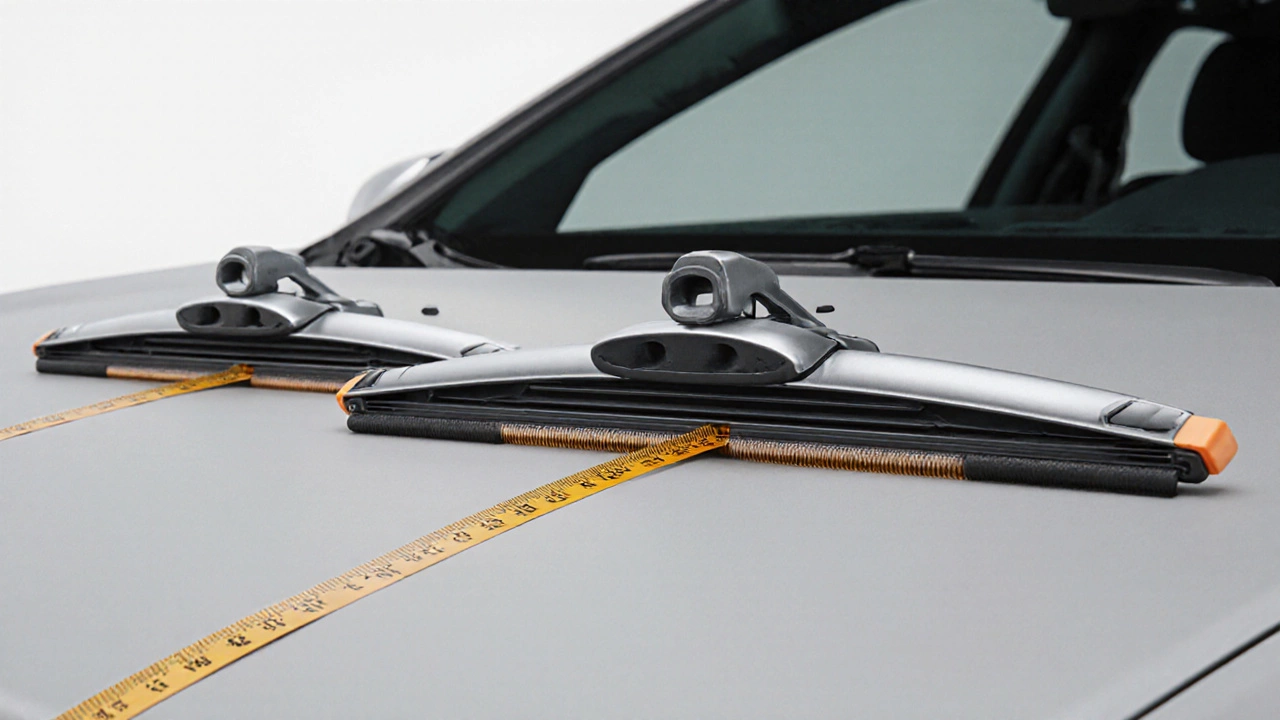Windshield Wiper Selector Tool
Your Wiper Information
How to Measure
1. Turn wiper arms to vertical position
2. Measure from pivot point to blade tip
3. Write down both sides - many vehicles use different lengths
4. Check owner's manual for exact specs
Climate Considerations:
Winter: Must stay flexible below -20°C (-4°F)
Hot: Must resist UV degradation
All-Season: Balanced for moderate temperatures
Key Takeaways
- Know the four main wiper blade designs and which weather they excel in.
- Measure your vehicle’s blade length accurately to avoid gaps or overlap.
- Pick a rubber compound that matches your climate - all‑season, winter, or high‑temperature options.
- Check the mounting system (hook, pin, bayonet) before buying to ensure a hassle‑free install.
- Consider OEM versus reputable aftermarket brands for durability and budget.
In short, selecting the right windshield wipers is essential for safe driving.
When it comes to clear visibility in rain, windshield wiper is a mechanical device that clears water, snow, and debris from a vehicle’s windshield using a rubber blade attached to a moving arm. Choosing the right one can make a huge difference in safety and comfort.
1. Understanding the Main Wiper Blade Types
Modern wipers fall into four basic categories. Each uses a different frame and blade construction, which affects performance, streaking, and durability.
Conventional frame features a metal or plastic skeleton with a separate rubber blade that slides over the frame. This classic design is inexpensive but can lose pressure on curved windshields, leading to streaks.
Beam blade uses a sleek, aero‑shaped frame that holds the rubber edge in place without external supports. The lack of hinges provides even pressure across the glass, making it a top choice for most drivers.
Winter blade adds a rubber cover or winter‑specific coating that resists ice buildup and stays flexible in sub‑zero temperatures. Ideal for regions that see snow and freezing rain.
Hybrid blade combines the low‑profile frame of a beam blade with the added strength of a conventional backing, offering a balance of durability and cost. Great for drivers who want beam performance without the premium price.
2. Measuring the Correct Blade Length
Using a blade that’s too short leaves water patches; a blade that’s too long can “wobble” and damage the glass. Follow these steps to measure accurately:
- Turn the wiper arms to the vertical position.
- Measure from the pivot point (where the arm attaches to the motor) to the tip of the rubber edge.
- Write down each length; many cars use different sizes for driver‑side and passenger‑side.
- Check the vehicle’s owner manual or the sticker on the old blade for exact specifications.
The measurement you record is known as the blade length the distance, usually in inches, from the wiper arm’s pivot to the blade’s tip.. Buying a blade that matches this length ensures full coverage without over‑reach.

3. Matching Blade Material to Your Climate
The rubber component of a wiper determines how well it grips the glass and how long it lasts. Here are the most common compounds:
- All‑season rubber: Balanced hardness; works well in moderate temperatures and occasional rain.
- Winter‑grade silicone: Remains supple below -20°C, resists cracking, and sheds snow better.
- High‑temperature EPDM: Designed for hot climates; resists UV degradation and retains elasticity in summer heat.
When shopping, look for the weather rating a label indicating the blade’s optimal temperature range and performance characteristics.. Selecting a blade that aligns with your local weather saves you from replacing them every few months.
4. Mounting Systems - Hook, Pin, or Bayonet?
Even the perfect blade won’t work if it doesn’t fit your car’s mounting style. The three most common attachment methods are:
| System | Typical Use | Installation Ease | Common Issues |
|---|---|---|---|
| Hook | Most European models | Simple clip‑on | Can loosen over time |
| Pin | Older American cars | Requires a small hole | Pin can bend |
| Bayonet | Many Asian makes | Twist‑lock action | Needs precise alignment |
The mounting bracket the metal or plastic piece on the wiper arm that holds the blade in place. must match one of these systems. Before buying, examine your old blade’s attachment or consult the vehicle’s manual.
5. OEM vs. Aftermarket - Which Gives Better Value?
Original Equipment Manufacturer (OEM) wipers are the same part that came with the car at the factory. Aftermarket brands are made by third‑party companies and often claim superior materials for a lower price.
OEM wipers produced by the vehicle’s original supplier, adhering to the automaker’s specifications. They guarantee a perfect fit but can be pricey.
Aftermarket wipers made by independent manufacturers, offering a range of designs and price points. Look for reputable brands that provide a warranty and list the exact blade length and mounting type.
For most drivers, a high‑quality aftermarket blade (especially a beam or hybrid) delivers the same performance as OEM at a fraction of the cost.

6. Maintaining Your Wipers for Longevity
Even the best blades wear out. Simple upkeep can stretch their life by months:
- Wipe the rubber edge with a soft cloth and a dab of wipe‑away fluid a mild cleaner designed for rubber and glass. after each heavy rain.
- Lift the wiper arms off the glass when the car sits in direct sunlight for long periods; this prevents the rubber from bonding to the glass.
- Replace the rubber blade when you notice squeaking, streaking, or reduced contact.
Pay attention to the wiper arm the metal lever that moves the blade across the windshield.. Bent or corroded arms can cause uneven pressure, making even a new blade perform poorly.
7. Quick Decision Checklist
- Identify your climate - all‑season, winter, or hot.
- Measure blade length for each side.
- Check mounting type (hook, pin, bayonet).
- Pick frame style: beam for most, winter for snow‑heavy areas.
- Choose OEM for exact match or reputable aftermarket for savings.
Frequently Asked Questions
How often should I replace my windshield wipers?
Most experts recommend swapping them every 12‑18 months, but if you hear squeaking, see streaks, or live in harsh weather, replace sooner.
Can I mix different wiper types on the same car?
Yes. It’s common to use a beam blade on the driver side for performance and a winter blade on the passenger side for snow. Just ensure both match the correct blade length and mounting system.
What’s the difference between a ‘rain‑sensing’ wiper and a regular one?
Rain‑sensing systems use a sensor on the windshield to adjust speed automatically. They work with any compatible blade, but you still need to choose the right blade type for clear wiping.
Are silicone wiper blades better than rubber?
Silicone stays flexible at lower temperatures and resists UV damage, making it a solid choice for extreme climates. However, it’s often pricier, and the performance gain is most noticeable in winter conditions.
How do I know if my wiper arm is bent?
Lay the arm on a flat surface; if it wobbles or doesn’t lie flat, it’s likely bent. A bent arm can cause uneven pressure and should be replaced or straightened.


